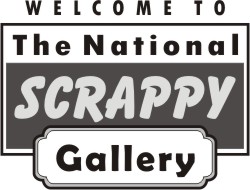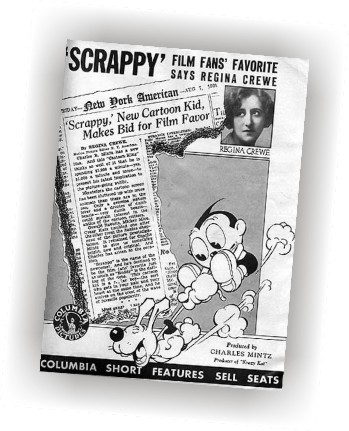
Updated August 2005
Someday, this country may have the world-class Scrappy museum that it deserves. (We envision it as a new outpost of the Smithsonian.) Until that happy day arrives, consider this section of Scrappyland–dedicated to Scrappy merchandise, publications, and marketing–to be the next best thing, virtually speaking.
Whether Scrappy was ever genuinely popular with audiences remains a debatable proposition. But he was certainly merchandised like a star. In theory, a kid of the 1930s could get up, bathe using Scrappy soap, don his Scrappy necktie, head off to school with his Scrappy fountain pen and art supplies in tow, use a Scrappy sandpail at recess, delve into a Scrappy comic book or Big Little Book at lunch, and blow his nose into a Scrappy hankerchief during math class–and then go home to play with his Scrappy puppet theatre and deposit his allowance into his Scrappy bank before turning on his Scrappy nightlight, grabbing his Scrappy doll, and hopping into bed to dream of Scrappy. You couldn’t say that about Kiko the Kangaroo or even Oswald the Rabbit.
Scrappyland’s Scrappy collection is growing, but far from complete. Most of the images here come from items in our archives, but we’ve borrowed a few from elsewhere. Visit often–we plan to expand this place, piece by piece.
For starters, let’s look at some Scrappy publicity materials.

The first Scrappy cartoon debuted in July, 1931–so the above ad from The Columbia Showman for October 1st, 1931 would count among the earliest Scrappy-related promotinal items. The art (with a particularly fine Yippy) is by Scrappy creator Dick Huemer, but the piece focuses on a New York American story by celebrity film critic Regina Crew in which she lavishes praise on “Charlie” Mintz. (“It remained for Charlie Mintz to give us something bright, new and original. And Charles has risen to the occasion. ‘Scrappy’ is the name of the newcomer. And he’s destined to be the film fan’s favorite just as much as ‘Buddy’ is the darling of the debs.”)
Crewe also says that Mintz spent “$1,000 a minute and more” on Scrappy shorts. From what we know about the cost of animated film production in the early 1930s–which we’ve mostly gleaned from Mike Barrier’s Hollwood Cartoons–that wasn’t a particularly princely sum. In fact, it was kind of ordinary.

Above is another early trade ad for Scrappy cartoons illustrated by Dick Huemer. This may be the best Scrappy drawing ever done–and that’s the early Scrappy to a T, with enormous head, hands, and feet; tiny body; and trying-a-little-too-hard grin. The text on the left reads:
“Columbia has organized a ‘Scrappy’ Cartoon School which will be carried on with the cooperation of Public Schools in your district. This free course will bring hundreds of children to your theatre on the days when ‘Scrappy’ is shown! Other national tie-ups, novelties, and accessories are daily adding ready-made exploitation on this feature for you to profit on! See your exchange for details.”
The notion of 1930s teachers willingly turning their classrooms into centers of Scrappy promotion is at once risible, disturbing, and somehow touching. And boy, would we love to talk to any senior citizens who have memories (fond or otherwise) of their Scrappy Cartoon School lessons.
Here’s the text on the right:
“A Novel Cartoon Series Typifying the American Boy! All the amusing pranks, all the naivete, the humor, and whimsicalities of growing youth, in a series as interesting as your own boy! A feature that appeals to everyone!”
Sounds positively wholesome, as if watching Scrappy cartoons were good for one’s constitution, doesn’t it?


The first kid to wear his hat backward?
I have a scrappy doll…. I’ve tried to find information about him on the Internet haven’t had much luck
I recently purchased a collection of salesman memorabilia. It’s all from the 1930s and some of it’s Scrappy. A Salesman booklet, toys, posters, newsprint ads
Long live Yippy!